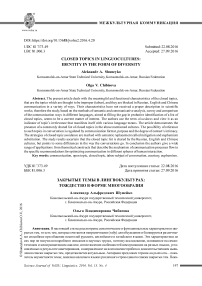Closed topics in linguocultures: identity in the form of diversity
Автор: Shuneyko Aleksandr A., Chibisova Olga V.
Журнал: Вестник Волгоградского государственного университета. Серия 2: Языкознание @jvolsu-linguistics
Рубрика: Межкультурная коммуникация и сопоставительное изучение языков
Статья в выпуске: 4 т.15, 2016 года.
Бесплатный доступ
The present article deals with the meaningful and functional characteristics of the closed topics, that are the topics which are thought to be improper (taboo), and they are blocked in Russian, English and Chinese communication in a variety of ways. Their characteristics have not received a proper description in scientific works; therefore the study, based on the methods of semantic and communicative analysis, survey and comparison of the communication ways in different languages, aimed at filling the gap in probative identification of a list of closed topics, seems to be a current matter of interest. The authors use the term closedness and view it as an indicator of topic’s irrelevance that manifests itself with various language means. The article demonstrates the presence of a commonly shared list of closed topics in the above mentioned cultures. The possibility of reference to such topics in conversation is regulated by communication format, purpose and the degree of contact’s intimacy. The strategies of closed topic avoidance are marked with semantic replacement called mitigation and euphemism substitution. The study results ascertain that the closed topic list is shared by the Russian, English and Chinese cultures, but points to some differences in the way the conversations go. In conclusion the authors give a wide range of applications: from theoretical constructs that describe the mechanism of communication processes flow to the specific recommendations for optimizing communication in different spheres of human interaction.
Communication, open topic, closed topic, taboo subject of conversation, courtesy, euphemism
Короткий адрес: https://sciup.org/14970014
IDR: 14970014 | УДК: 81’373.49 | DOI: 10.15688/jvolsu2.2016.4.20
Список литературы Closed topics in linguocultures: identity in the form of diversity
- Chibisova O.V. K voprosu ob ispolzovanii evfemizmov v mezhkulturnoy kommunikatsii . Vestnik Dagestanskogo gosudarstvennogo universiteta. Seriya 2. Gumanitarnye nauki, 2013, no. 3, pp. 220-224.
- Eysfeld Е.A. Funktsionirovanie ehvfemizmov v politicheskom diskurse Vestnik Volgogradskogo gosudarstvennogo universiteta. Seriya 2, Yazykoznaniye , 2016, no. 1 (30), pp. 131-136 DOI: 10.15688/jvolsu2.2016.1.17
- Hatch L. Taboo Deformation: How the Fear of Bears and Wolves Manifested Itself in IndoEuropean Culture. Available at: http://www. academia.edu/12423628/Taboo_Deformation_ How_the_Fear_of_ Bears_and_Wolves_Manifested_ Itself_in_Indo-European_Culture.
- Rubin N.A. Mrs. Grundy’s Studies in English Prudery. Available at: http://www.unlikelystories.org/old/articles/rubin1003.html.
- Shuneyko A.A., Avdeenko I.A. Аdaptatsiya kommunikativnogo prostranstva pod svoi zadachi kak etap realizatsii stsenariev informatsionno-kommunikativnykh sobytiy . Uchenye zapiski Komsomolskogo-na-Amure gosudarstvennogo tekhnicheskogo universiteta, 2012, vol. 2, no. 9, pp. 48-56.
- Zhahanova Z.R. Taboos and euphemisms in the English and Kazakh languages. Available at: http://www.econf.rae.ru/article/7758.
- Zhang C. Evfemizatsiya v russkom i kitayskom yazykakh: lingvokulturologicheskiy i lingvo-pragmaticheskiy aspekty: dis.... kand. filol. nauk . Volgograd, 2013. 208 p.


